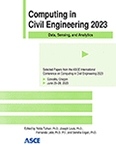Underground Railway Station Passenger Flow Prediction Based on Long Short-Term Memory Neural Network
Publication: Computing in Civil Engineering 2023
ABSTRACT
With the rapid expansion of underground railway systems and the increase in public transportation ridership, short-term metro passenger flow forecasting has become one of the prevalent topics in transportation planning, infrastructure construction and improvement, and underground railway monitoring and management. This paper proposes a short-term metro passenger prediction approach based on long short-term memory neural network (LSTM NN). The big data of historical metro passenger flow, the holiday information, and the characteristic of stations are taken into consideration. The prediction performance is evaluated by mean absolute error (MAE) and root mean squared error (RMSE). Experiments are conducted based on Hong Kong Mass Transit Railway (MTR) data, and the result indicates that the proposed model has a higher accuracy than baseline models. The novel model provides an option for stakeholders to achieve a high-performance prediction of metro passenger flow. By obtaining future passenger flow data in advance, the authorities can make appropriate decisions on real-time underground railway system management and deliver timely responses to unexpected events.
Get full access to this article
View all available purchase options and get full access to this chapter.
REFERENCES
Chen, C., Ma, J., Susilo, Y., Liu, Y., and Wang, M. (2016). “The promises of big data and small data for travel behavior (aka human mobility) analysis.” Transportation Research Part C: Emerging Technologies, 68, 285–299.
Chen, M.-C., and Wei, Y. (2011). “Exploring time variants for short-term passenger flow.” Journal of Transport Geography, 19, 488–498.
Fu, X., Zuo, Y., Wu, J., Yuan, Y., and Wang, S. (2022). “Short-term prediction of metro passenger flow with multi-source data: A neural network model fusing spatial and temporal features.” Tunnelling and Underground Space Technology, 124.
Halyal, S., Mulangi, R. H., and Harsha, M. M. (2022). “Forecasting public transit passenger demand: With neural networks using APC data.” Case Studies on Transport Policy, 10, 965–975.
Hochreiter, S. (1998). “The vanishing gradient problem during learning recurrent neural nets and problem solutions.” International Journal of Uncertainty, Fuzziness and Knowledge-Based Systems, Vol. 6, No.2, 107–116.
Hochreiter, S., and Schmidhuber, J. U. (1997). “Long Short-Term Memory.” Neural Computation, 9(8), 1735–1780.
Lee, S., and Fambro, D. (1999). “Application of subset autoregressive integrated moving average model for short-term freeway traffic volume forecasting.” Transportation Research Record: Journal of the Transportation Research Board, 1678, 179–188.
Leng, B., Zeng, J., Xiong, Z., Lv, W., and Wan, Y. (2013). “Probability tree based passenger flow prediction and its application to the Beijing subway system.” Frontiers of Computer Science, 7, 195–203.
Ou, J., Xia, J., Wu, Y.-J., and Rao, W. (2017). “Short-term traffic flow forecasting for urban roads using data-driven feature selection strategy and bias-corrected random forests.” Transportation Research Record: Journal of the Transportation Research Board, 2645, 157–167.
Smith, B. L., and Demetsky, M. J. (1997). “Traffic flow forecasting: comparison of modeling approaches.” Journal of Transportation Engineering, Vol. 123, No.4.
UITP (The International Association of Public Transport). (2022). “World Metro Figures 2021.” <https://cms.uitp.org/wp/wp-content/uploads/2022/05/Statistics-Brief-Metro-Figures-2021-web.pdf>(May, 2022).
Vlahogianni, E. I., Karlaftis, M. G., and Golias, J. C. (2014). “Short-term traffic forecasting: Where we are and where we’re going.” Transportation Research Part C: Emerging Technologies, 43, 3–19.
Wang, J., Wang, R., and Zeng, X. (2022). “Short-term passenger flow forecasting using CEEMDAN meshed CNN-LSTM-attention model under wireless sensor network.” IET Communications, 16, 1253–1263.
Wang, J., Zhang, Y., Wei, Y., Hu, Y., Piao, X., and Yin, B. (2021a). “Metro Passenger Flow Prediction via Dynamic Hypergraph Convolution Networks.” IEEE Transactions on Intelligent Transportation Systems, 22, 7891–7903.
Xie, Z., Zhu, J., Wang, F., Li, W., and Wang, T. (2020). “Long short-term memory based anomaly detection: A case study of China railway passenger ticketing system.” IET Intelligent Transport Systems, 15, 98–106.
Zhang, L., Liu, Q., Yang, W., Wei, N., and Dong, D. (2013). “An Improved K-nearest Neighbor Model for Short-term Traffic Flow Prediction.” Procedia - Social and Behavioral Sciences, 96, 653–662.
Zhang, Z., Han, Y., Peng, T., Li, Z., and Chen, G. (2022). “A Comprehensive Spatio-Temporal Model for Subway Passenger Flow Prediction.” ISPRS International Journal of Geo-Information, 11(6), 341.
Information & Authors
Information
Published In
History
Published online: Jan 25, 2024
ASCE Technical Topics:
- Construction engineering
- Engineering fundamentals
- Infrastructure
- Model accuracy
- Models (by type)
- Passengers
- Public transportation
- Rail transportation
- Railroad stations
- Special condition construction
- Structural engineering
- Structures (by type)
- Subways
- Terminal facilities
- Transportation engineering
- Transportation management
- Underground construction
- Underground structures
Authors
Metrics & Citations
Metrics
Citations
Download citation
If you have the appropriate software installed, you can download article citation data to the citation manager of your choice. Simply select your manager software from the list below and click Download.
